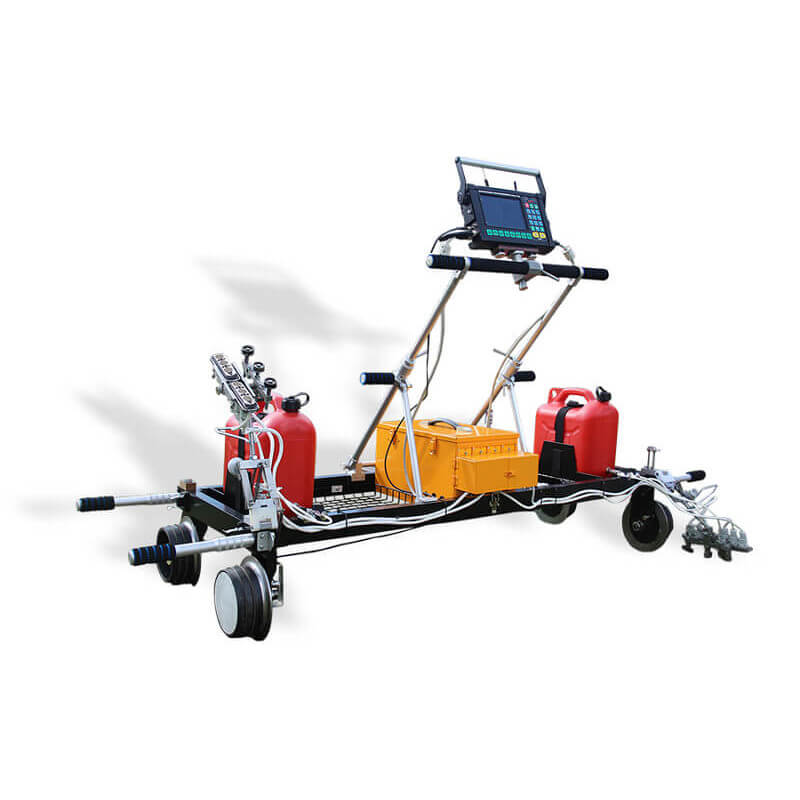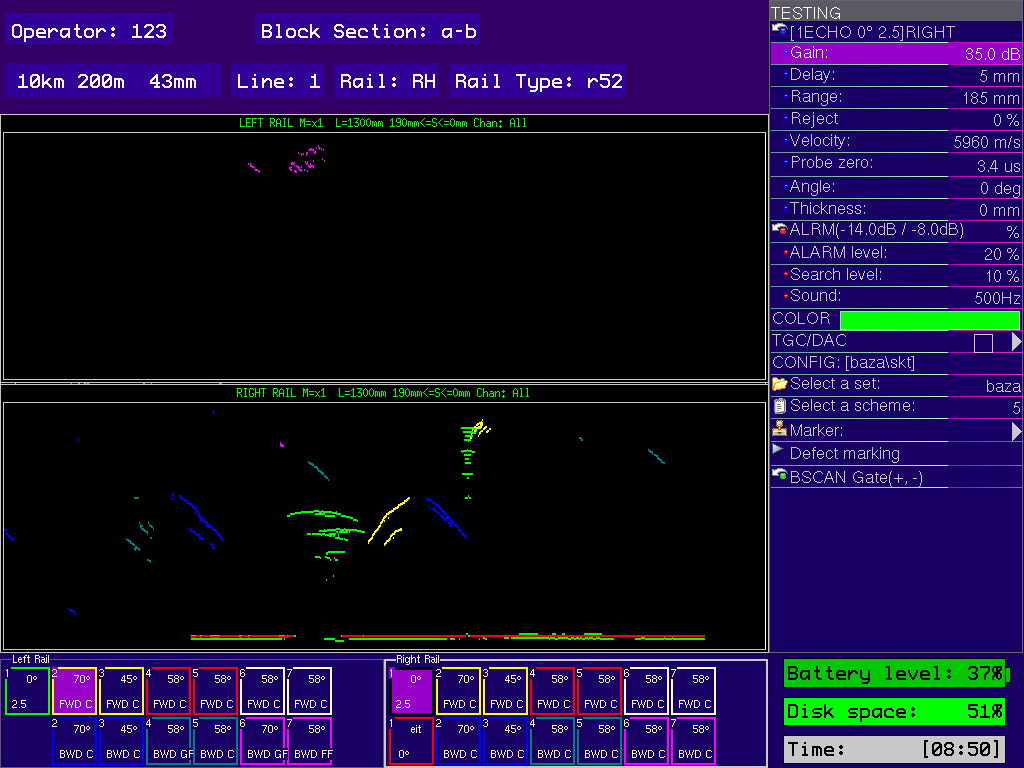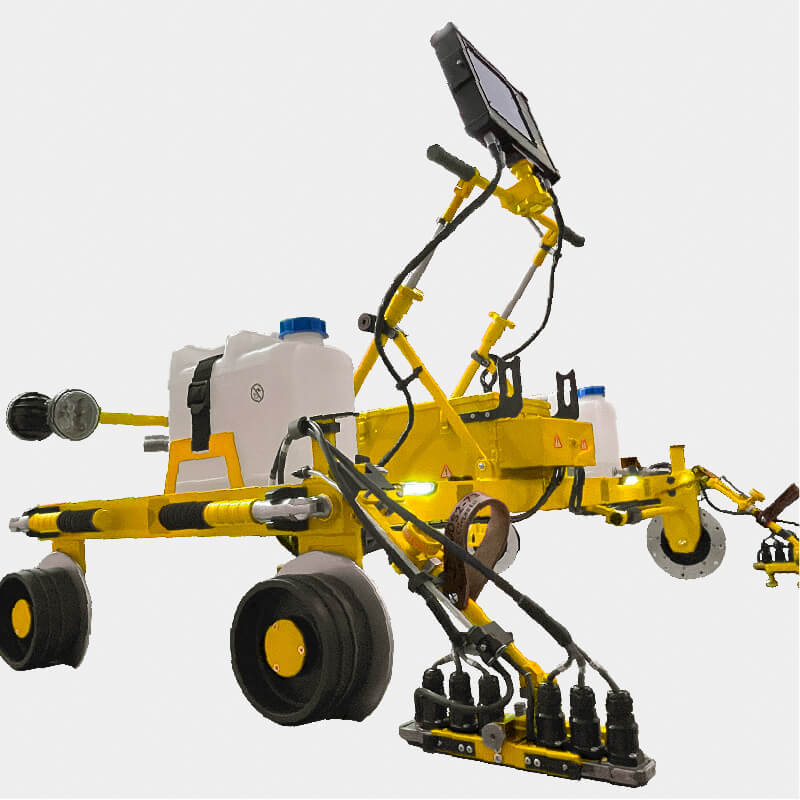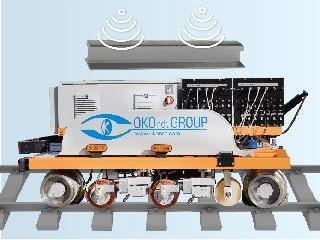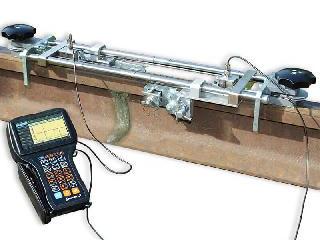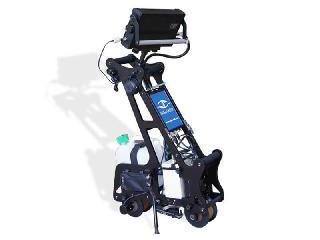
The flaw detector is intended for defect detection on the running surface of both rails and in the rail cross-section, excluding rail base blades. It employs a flaw detection trolley for continuous testing and manual probes for confirmatory testing of individual rail cross-section segments and welded joints.

Ergonomic and Reliable
The UDS2-73 is intended for continuous inspection of rails and railway switches at a speed of 4 km/h with further verification of indications via the hand testing procedure.
The flaw detector consists of an electronic unit, 4 multiplexer units, 26 probe units, a storage battery, and 2 couplant tanks fixed onto a trolley.
Multiple channels (28 for continuous testing and 3 for hand testing) are capable of providing complete inspection of the rail (excluding its base blades). Every other millimeter of traveled distance is scanned with the results saved to the internal memory.
The recorded data can be presented as A-scan, B-scan, or A-scan + B-scan. The results can be retrieved as individual reports linked to path and GPS coordinates.
Instrument Service Functions
- sound and visual alarm, mode switching with the help of "hot buttons";
- electronic registration of test results from all channels allows reinterpreting them and making complete reports;
- mode of determining the rail type and automatic correction of settings;
- mode of testing bolt holes with special settings;
- B-Scan in real time is used from one, two or four channels (of the left and right rails of driving-into and driving-out channels) for the in-depth analysis of detected signals, apart from the common information display in the form of А-scan;
- possibility of TCG curve (of any shape) plotting.

Key features:
- compliant with EN 16729-1 “Railway applications – Infrastructure – NDT on rails in track – Requirements for ultrasonic inspection and evaluation principles”; ETN-01-04 “Manual for Non-destructive Testing of rails” and other regulations;
- a high contrast TFT display;
- switching modes with “hot buttons”;
- mode of determining the rail type and automated adjustment of settings;
- sound and visual alarm;
- special mode for testing bolt holes;
- TCG curve plotting.


Probe units
The UDS2-73 flaw detector employs contact probe units of conventional type with both standard and specialized probes.
The probe units are made from wear resistant plastic material, with hard-metal inserts on the working surface.
The probe units comprise the following probes:
| Probe unit №1: | Probe unit №2: |
| 0° probe — 4 MHz | 4х58°х34° probe — 2.5 MHz |
| 70° probe — 2.5 MHz (Forward) | 70° probe — 2.5 MHz (Backward) |
| 4х58°х34° probe — 2.5 MHz | 2х45° probe — 2.5 MHz (Forward/Backward) |
GET A QUICK QUOTE FROM US TODAY
REQUEST A QUOTETechniques and areas of testing
rail head
- echo technique with an angle-beam probe for testing the field and gage side of the railhead in the direction of motion and against the direction of motion;
- echo technique with an angle-beam probe for testing the central part of the railhead in the direction of motion and against the direction of motion;
- echo-mirror technique with an angle-beam probe for testing the central part of the railhead in the direction of motion and against the direction of motion;
- echo-mirror technique with an angle-beam probe for testing the field and gage side in the direction of motion and against the direction of motion;
web and its projection in the base
- echo and mirror-shadow techniques with a straight-beam single-crystal probe for detection of longitudinal horizontal cracks;
- echo techniques with an angle-beam probe in the direction of motion and against the direction of motion for detection of transverse cracks and testing bolt holes;

Fig. Echo techniques for railhead testing
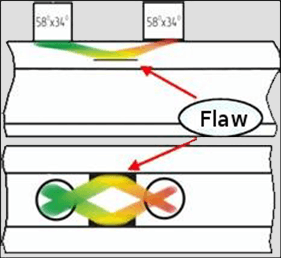
Fig. Echo-mirror techniques for railhead testing

Fig. Echo techniques for testing the web and base
The flaw detector using the standard scanning schemes enables detecting all types of fatal defects with the following features:
- transverse cracks in the 2nd-category railhead, including well-developed transverse cracks with reflecting surface, and also the ones developing under horizontal rolling surface separations which are not detected by the standard echo technique;
- longitudinal horizontal cracks in the web, even if they do not reach the rail axis in their development, and also in the head, including the ones that do not go beyond the web projection;
- longitudinal horizontal cracks located in the middle of the rail height;
- cracks from bolt holes, including the ones at an early stage of their development when they do not go beyond the bolt hole projection onto the roll surface;
- vertical cracks in the base and web located mainly along the rail axis;
- transverse corrosion cracks in the base located in the web projection area.
Fig. Modes of testing results display in A-scan and B-scan on the flaw detector screen
Additional Software
"LuCH-Controller 1.6" is intended for viewing and analyzing test results of UDS2-73 ultrasonic rail flaw detector, as well as for interpretating and displaying information on suspicious rail sections. The present program facilitates operation with the data stored on a PC.
Main advantages of program application are:
- convenient operation with the tested section (span) database;
- selection of various groupings of testing channels, tested rail, tested area, testing technique;
- measurement of defect conditional dimensions in B-scan mode;
- viewing А-scan viewing based on the data recorded in B-scan mode;
- viewing the defectogram (B-scan) in scroll mode or in mode of fast switch to the set coordinate;
- path marking for marking suspicious rail sections while viewing test results;
- mode of filtering test results by the sensitivity level from minus 6 to plus 6 dB in relation to the ALARM level;
- mode of viewing and producing reports on the section selected for testing.
Main specifications:
| Overall dimensions of flaw detector without a handle and with one ultrasonic unit and power unit | no more than (1040×1640×1130) mm; in transport position – no more than (900×2060×600) mm. | |
| Equipped flaw detector weight | no more than 50 kg. | |
| Keypad | English, Russian. | |
| Languages | English, Russian. | |
| Number of ultrasonic units | 4 | |
| Number of ultrasonic channels | 26 channels for continuous inspection and 2 for manual verification. | |
| Connector types | BNC, RS-19. | |
| Data storage | Flash card. | |
| Independent power source | NiMH storage battery of rated voltage 12 V and rated capacity 17 А∙h. | |
| Operation time | 10 hours. | |
| Flaw detector consumed electric power | no more than 30 V•А. | |
| Time of flaw detector operation mode setup | no more than 15 sec. | |
| Display resolution | 800×480 pixels. | |
| Screen dimensions (width, height, diagonal) | 155 mm, 95 mm, 180 mm (7.5 inches). | |
| Warranty | 1 year. | |
| Interfaces | ||
| USB | USB-A (host), USB-B (slave). | |
| Trigger O | available. | |
| Headphones | available. | |
| Encoder output | Single-coordinate encoder. | |
| Main metrological performances | ||
| The limits of admissible main absolute error of flaw detector during the measurement of depth dН and coordinates |
| |
| The limits of admissible main absolute error during the measurement of signals amplitudes ratio ∆N at the reception path input in the gain range from 20 dB to 80 dB | ∆N = ±(0.2+0.03N); ∆N ─ main absolute error during signals amplitudes ratio measurement, dB; | |
| Time instability of flaw detector reception path sensitivity | ± 0.5 dB for 8 hours of continuous operation. | |
| Protection level in operation | IP 64 | |
| Ambient temperature | from minus 400 to plus 500С. | |
| Atmospheric pressure | from 84 to 106,7 kPa. | |
Relative humidity | (93 ± 3) at a temperature 25 ºС. | |
| Flaw detector in shipping package is resistant to the influence of |
| |
| Flaw detector retains its parameters when it is influenced by electromagnetic interferences which do not exceed the following norms |
| |
| Full average flaw detector lifetime | no less than 10 years. | |
| Probability of no-failure operation | no less than 0.9 for 2 000 h. | |
| Pulser | ||
| Initial pulse type | Short pulse of negative polarity. | |
| Initial pulse frequency | One-channel mode – 250 Hz; complete mode – no more than 1000 Hz. | |
| Amplitude | 180 V | |
| Duration | 60±10 ns | |
| Rising edge duration | no more than 20 ns. | |
| Synchronization type | from an initial pulse, from an encoder. | |
| Receiver | ||
| Gain | from 0 to 100 dB with a step of 0.1, 1, 10 dB. | |
| Input signal | no more than 2 V from a peak to a peak. | |
| Input reception path resistance | no more than 300 Ω. | |
| Digital filter | 1 standard digital filter with central frequency 2.5 MHz. | |
| Rectifier | envelope. | |
| Setups mode | ||
| Measurements | mm | |
| Testing range | from 0 to 1000 mm, with a step 1, 10, 100 mm. | |
| Velocity | from 2000 m/s to 8000 m/s, with a step 1, 10, 100, 1000 m/s. | |
| Probe zero | from 0 to 60 µs, with a step 0.1, 1 µs. | |
| Range delay | from 0 to 1000 µs, with a step 1, 10, 100 µs. | |
| Probe angle | from 0 to 900, with a step 10, 100 | |
| Cycles/gates | ||
| Number of cycles | max. number of cycles 16. | |
| Cycle duration | 0.01 - 0.4 ms. | |
| Number of gates in a cycle | max. number of gates 2 for each channel. | |
| Gate fixation level | from 0 % to 100 % of vertical screen scale. | |
| ALARM | When the signal goes beyond the ALARM level, when the signal stays within the ALARM level. | |
| ALARM system | ||
| Sound ALARM system | sound – separate for each rail and combined (for a group of channels); range of pulse frequency setup of alarm system sound indicator is from 0.5 to 5 kHz, with a step 100 Hz. | |
| Light ALARM | light – separate for each rail and combined (via all ensounding channels); visual by the screen – separate for each rail and each channel. | |
| Measurements in A-scan mode | ||
| Displayed parameters | 4 measuring parameters are displayed in a status bar. | |
| ||
TCG curve | max. number of points is 14 per cycle, dynamic range 100 dB, vertical setup step 1 dB, horizontal – 2 mm. | |
| Measurements in B-scan mode | ||
| "Raw" B-scan |
| |

